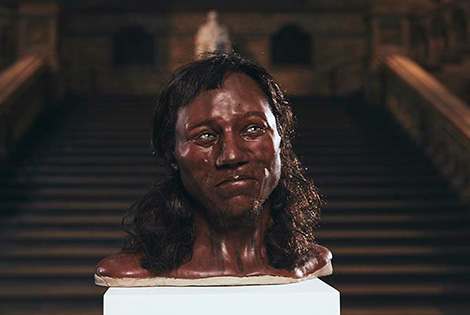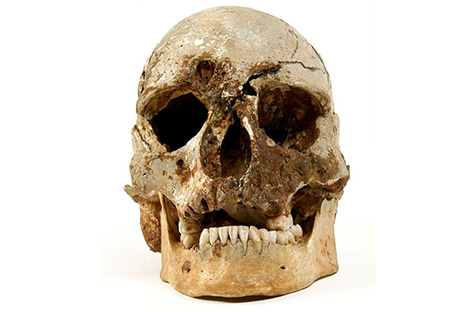
The reconstruction of the Cheddar Man, a clay sculpt upon a digitally produced skull base. [credit: Tom Barnes/Channel 4]
The 10,000 year old ‘Cheddar Man’, the oldest almost complete skeleton of our species, Homo sapiens, ever found in Britain, has been brought to life for a new television documentary using the latest 3D technology.
Using a Mesolithic skeleton and its DNA, discovered in 1903 at Gough’s Cave in Cheddar Gorge, Somerset, scientists as well as reconstruction experts Kennis & Kennis have rendered a physical model from a base of 3D scanning and 3D printing technologies.
The original skull was 3D scanned to capture the full detail as an STL file, before Kennis & Kennis printed the skull using their in-house 3D printer, before building up clay to produce the lifelike representation.

The skull of the oldest complete skeleton of a human found in Britain, 3D scanned by Patrick Thorne for the project [credit: Natural History Museum]
The final stages included adding the skin pigmentation, usually associated with that of sub-saharan Africa, and bright blue eye colour, were based upon the
“Cheddar Man subverts people’s expectations of what kinds of genetic traits go together,” said Dr Tom Booth, a postdoctoral researcher at the Natural History Museum, who works closely with the Museum’s human remains collection.
“It seems that pale eyes entered Europe long before pale skin or blond hair, which didn’t come along until after the arrival of farming.
“He reminds us that you can’t make assumptions about what people looked like in the past based on what people look like in the present, and that the pairings of features we are used to seeing today aren’t something that’s fixed.”
The full process and story of the Cheddar Man can be seen at 8pm on Sunday 18 February, on Channel 4.






